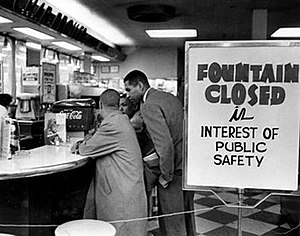Nashville sit-ins
| Nashville sit-ins | |||
|---|---|---|---|
| Part of the Civil Rights Movement | |||

Nashville's sit-in campaign targeted downtown lunch counters such as this one at Walgreens drugstore.
|
|||
| Date | February 13 – May 10, 1960 (2 months, 3 weeks and 6 days) |
||
| Location | Nashville, Tennessee | ||
| Causes |
|
||
| Result |
|
||
| Parties to the civil conflict | |||
|
|||
| Lead figures | |||
|
|||
Students
Lawyers
The Nashville sit-ins, which lasted from February 13 to May 10, 1960, were part of a nonviolent direct action campaign to end racial segregation at lunch counters in downtown Nashville, Tennessee. The sit-in campaign, coordinated by the Nashville Student Movement and Nashville Christian Leadership Council, was notable for its early success and emphasis on disciplined nonviolence.
Over the course of the campaign, sit-ins were staged at numerous stores in Nashville's central business district. Sit-in participants, who consisted mainly of black college students as well as some white students who oppose segregation, were often verbally or physically attacked by white onlookers. Despite their refusal to retaliate, over 150 students were eventually arrested for refusing to vacate store lunch counters when ordered to do so by police. At trial, the students were represented by a group of 13 lawyers, headed by Z. Alexander Looby. On April 19, Looby's home was bombed; however, neither he nor his wife was injured. Later that day, nearly 4000 people marched to City Hall to confront Mayor Ben West about the escalating violence. When asked if he believed the lunch counters in Nashville should be desegregated, West agreed that they should. After subsequent negotiations between the store owners and protest leaders, an agreement was reached during the first week of May. On May 10, six downtown stores began serving black customers at their lunch counters for the first time.
Although the initial campaign successfully desegregated downtown lunch counters, sit-ins, pickets, and protests against other segregated facilities continued in Nashville until passage of the Civil Rights Act of 1964, which ended overt, legally sanctioned segregation nationwide. Many of the organizers of the Nashville sit-ins went on to become important leaders in the Civil Rights Movement.
In 1896, the United States Supreme Court decision Plessy v. Ferguson upheld the constitutionality of racial segregation under the doctrine of "separate but equal". This decision led to the proliferation of Jim Crow laws throughout the United States. These laws mandated segregation in virtually all spheres of public life and allowed racial discrimination to flourish across the country, especially in the Southern United States.
...
Wikipedia
